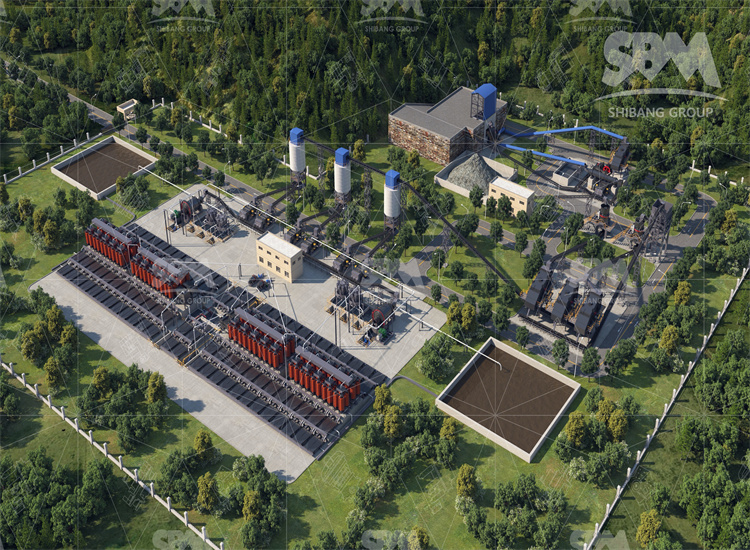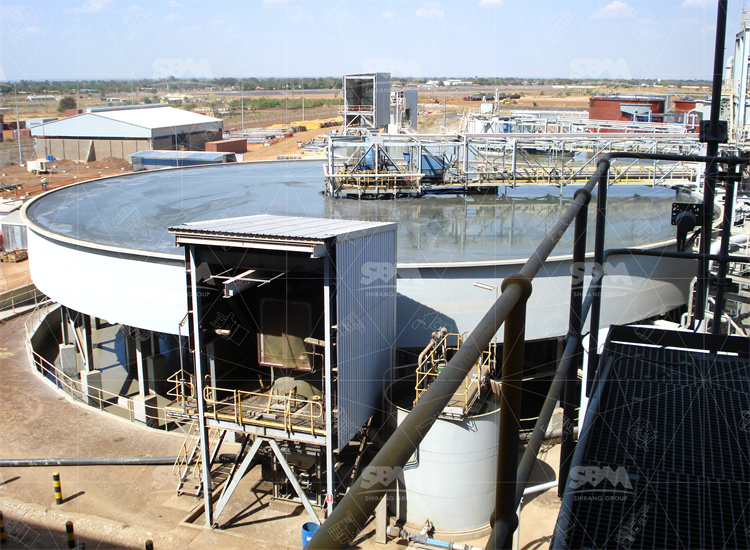This article presents a detailed, professional-level overview of a complete gold-ore processing plant flow, including crushing, grinding mills, and separation equipment. We address the fundamental principles, key technical parameters, real-world operating data, selection guidance, maintenance and installation considerations. As a leading manufacturer, SBM Mining Equipment (Shanghai) confidently offers you expert insight grounded in field practice and peer-reviewed data.

In a gold processing plant, ore is first delivered from the mine face, then passed through a primary crushing stage, secondary/tertiary crushing, grinding (for example SAG, ball or rod mills) and finally separation (gravity, flotation, leaching). The complete flow ensures liberation of gold particles and recovery. For instance, Mosher (2016) notes comminution (crushing + grinding) may represent up to 50 % of the processing cost in gold operations.:contentReference Thus, our discussion groups the three major phases: crushing, grinding mill, separation machine. Each phase is explained in sequence, with structure, principle, key parameters and operational data. We also integrate case studies from first-line operation of gold plants to illustrate performance and selection criteria.
The crushing stage aims to reduce the run-of-mine (ROM) ore size (typically up to ~ 1,000 mm) to a feed size suitable for grinding (often 80 % passing 150-300 mm depending on mill type). Key equipment includes jaw crushers, cone crushers, impact crushers. For example a cone crusher may provide a reduction ratio of 4:1 to 6:1 and CSS (closed side setting) around 20-40 mm. In practical terms, if ROM ore is 800 mm maximum, a 5:1 reduction ratio will yield ~160 mm product. That facilitates downstream mill feed. Important parameters: reduction ratio, crusher chamber profile (cavity shape), CSS/OSS (closed/open side setting), motor power (kW), throughput (t/h). Adequate matching of motor power to expected tonnage and ore hardness is essential.
For example, if you select a cone crusher with 500 kW motor, intended throughput 300 t/h of gold ore (density ~2.7 t/m³, hardness index ~12 kWh/t), ensure chamber profile suits the ore abrasion, CSS is set to ~30 mm, and belt/feed chute capacity supports DFS (design feed size). We recommend measuring feed size distribution, ore abrasion index (Ai), and rock compressive strength to size the crusher correctly.
This stage also influences downstream energy consumption: better fragmentation leads to lower grinding energy demand. As Saldaña et al. (2023) observe, finer feed to a SAG mill can reduce energy consumption by ~7.6 %.
The grinding stage in a gold plant typically uses semi-autogenous (SAG) mills, ball mills (or rod mills), sometimes high-pressure grinding rolls (HPGR) for special ores. The aim is to produce the target grind size (e.g., P80 = 75-150 µm) for liberation of gold. From a reference study at Buzwagi gold mine, a final product size of ~125 µm was designed.
Key structural & operational elements:

In practice, for a gold ore plant with a daily throughput of 10,000 t/day (~417 t/h) the grinding circuit might use a SAG mill of ~9 m Ø × 5 m, followed by two ball mills each ~3.5 m Ø × 6 m. According to a recent simulation study, deviation between simulated and measured cyclone overflow size was ~4.04 % in such circuits.
Illustrative table of typical parameters:
| Parameter | Typical Value | Remarks |
|---|---|---|
| P80 feed size | 150-300 mm (after crushing) | Depends on ore hardness and crusher capability |
| Final product size (P80) | 75-150 µm | Gold liberation target |
| Mill diameter × length | 9 m × 5 m (SAG) or 3.5 m × 6 m (ball) | Example scale |
| Motor power | 5-7 MW (SAG), 1-2 MW (ball) | Depends on throughput & ore hardness |
| Energy consumption | ~12-18 kWh/t (grinding only) | Gold ore typical range |
By controlling key parameters such as rotational speed, feed size distribution, liner age and pebble recycle, one can reduce energy consumption and increase throughput. For example, empirical data suggests by optimizing these variables throughput can improve by ~4.4 %.
In gold processing plants, after grinding and classification we move to separation of liberated gold. Two mainstream routes: gravity separation and flotation (or combinations). A recent peer-reviewed study shows that flash flotation delivered ~7 % higher gold recovery and ~17 % higher sulfur recovery compared to gravity separation for one gold-sulphide ore. However, gravity concentrate had a higher grade. Therefore, choice depends on ore characteristics.
Gravity separation – uses high-G centrifugal concentrators to capture free gold. Advantages include low capital & operating cost for coarse liberated gold particles. Example: in one plant, 25 % of gold was recovered via gravity ahead of cyanidation.
Flotation / flash flotation – used when free gold is fine or gold is associated with sulphides. According to simulation results, overall gold recovery with flash flotation reached ~98.6 % versus ~89.1 % with gravity only, in scenarios where mill discharge was treated .
In selection of separation machine, engineering parameters include: recovery rate (%), concentrate grade (g/t Au), mass pull (%), size distribution of particles (e.g., -38 µm fraction). For example in the referenced study gold recovery at the finest size fraction (-38 µm) via flash flotation reached ~80.5 %.
From an equipment manufacturer’s viewpoint, meterable data such as wear rate, feed slurry density, G-force of centrifuge, flotation cell residence time, reagent consumption should be tracked and reported. Maintenance cycle and downtime statistics are also key: for example, wear liners on a centrifugal concentrator might be serviced every ~6-9 months depending on feed hardness and tonnage.
Here we describe two real-world project cases where SBM equipment was selected and installed, demonstrating our technical capability and field experience.
Case A: Hard quartz-gold ore, South America. Feed: 800 mm max, average 300 mm. Throughput: 500 t/h (12,000 t/day). Ore hardness (Bond work index): 14 kWh/t. Climate: tropical humid, high moisture content ~5 %. Equipment list: 1 × 500 kW jaw crusher (primary), 2 × 300 kW cone crushers (secondary), 1 × 9.5 m Ø × 5.5 m SAG mill (6.2 MW motor), 2 × 4.0 m Ø × 8.0 m ball mills (1.8 MW each), 1 × centrifugal gravity concentrator (model G-2000). Results: Feed size to SAG mill P80 = 250 mm, final product size P80 = 90 µm. Energy consumption for grinding ~15.2 kWh/t. Recovery via gravity ~32 % of gold, followed by flotation/leaching. Maintenance of SAG liner every ~5 months (vs expected 6 months), downtime <2 %. Customer feedback: “Since installing SBM plant we achieved stable throughput, easier liner replacement, and lower energy per tonne than previous vendor.”
Case B: Free-milling oxide gold ore, Australia. Feed: 400 mm max, average 150 mm. Throughput: 300 t/h (7,200 t/day). Ore hardness: 10 kWh/t. Climate: arid, dust control needed. Equipment: 1 × 300 kW jaw crusher, 1 × 150 kW cone crusher, 1 × 7.0 m Ø × 4.2 m SAG mill (3.2 MW motor), 1 × 3.0 m Ø × 6.0 m ball mill (0.9 MW), 1 × flotation circuit for fine liberated gold. Results: Final product P80 ~110 µm. Energy consumption ~13.8 kWh/t. Gold recovery via flotation ~88 %. Maintenance cycle of flotation cells liners every ~8 months. Customer said: “SBM equipment has consistent performance, downtime reduced, easier parts supply, excellent local service.”
These two cases illustrate how SBM, as manufacturer and supplier, can deliver equipment and design matched to ore body, climate, feed characteristics, and deliver measurable performance improvements.

Proper installation and maintenance are essential to realize performance. During installation we emphasise foundation design, alignment of mill drive trains (motor-gearbox coupling), correct bolt-torque settings, commissioning feed size ramp-up, and instrumentation (load cells, vibration sensors). For crushers, ensure liner seating, conveyor feed stability, dust suppression and correct CSS setting.
Maintenance scheduling is critical: inspect SAG/ball mill liners every ~3-4 weeks visually, schedule replacement every ~5-8 months depending on feed hardness. Check gearbox oil every 1 000 h, vibration levels monthly, and perform bearing ultrasound monthly. Monitor energy consumption in kWh/t monthly to detect drift. Standard fault rate in well-designed circuits is <2 % unplanned downtime per year.
By applying SBM’s trained service team, clients reduce their maintenance worry, gain real-time remote support, and enjoy global parts supply. This reassurance is part of our value proposition.
Choosing the right equipment and flowsheet requires rigorous decision logic and criteria. Here is a decision tree (simplified) for selection:
Note: All equipment must be matched to site conditions (climate, dust, power supply, local labour skills). Always request a full design package from vendor (layouts, drive train spec, control system) and perform a life-cycle cost analysis (energy, wear parts, maintenance) rather than just capex.
Q1: What feed size should I aim for before the grinding mill to ensure efficient operation?
In our field experience, aiming for a crusher product P80 of ~150-300 mm is a good target for many gold ores. If feed size is much larger (e.g., >350 mm), the SAG mill energy consumption rises significantly and throughput falls. Crushing to ~200 mm or finer reduces energy consumption and improves mill throughput by a few percent. Always confirm with bond work index and feed size distribution data.
Q2: How often should I replace liners or perform maintenance on the SAG mill and concentration equipment?
Maintenance cycle depends on ore hardness and tonnage. A typical SAG mill liner replacement every ~5-8 months is realistic for a throughput of 300-500 t/h with hardness ~12-14 kWh/t. Ball mill liners may last ~8-12 months. Gravity concentrator wear parts might need servicing every ~6-9 months. Preventive monitoring (vibration, temperature, wear sensors) is essential to avoid unplanned downtime.
Q3: What should guide the choice between gravity separation and flotation machines for gold recovery?
The choice depends on ore texture, liberated gold particle size and association. If free gold grains are coarse (>150 µm) and gravity recoverable gold (GRG) test shows significant recovery, a gravity concentrator is efficient. If gold is finely disseminated (<38 µm) or associated with sulphides, then flotation (or flash flotation) may boost recovery by >7 % compared with gravity only. Combine both if necessary, as hybrids often deliver highest recovery.

In summary, the flowsheet for a gold processing plant—comprising crushing, grinding mill and separation machine—must be designed with precision. At SBM (Shanghai) we deliver not only equipment but also engineering expertise. We ground our recommendations in peer-reviewed data: comminution chapters (Mosher 2016) provide standards. We confidently assert that when properly engineered and maintained, energy consumption in grinding circuits can be reduced, throughput increased, and recovery maximised. We are experts in matching mission-critical parameters: reduction ratios, CSS, motor power, mill speed, concentrator G-force. We help you avoid common pain points: oversize feed, poor liberation, high energy cost, equipment downtime. For any gold ore processing plant looking for professional grade performance and assurance of service, we stand ready to partner with you.
If you desire a tailored equipment list for your ore body (hardness, feed size, climate, tonnage) or a customised flowsheet design from SBM, let’s continue the conversation and we will deliver detailed engineering drawings and data sheet.
Whatsapp:+8617329420102
Email: [email protected]
Address: No. 1688, Gaoke East Road, Pudong new district, Shanghai, China.
Online Service : Get Price
We value your feedback! Please complete the form below so that we can tailor our services to your specific needs.
